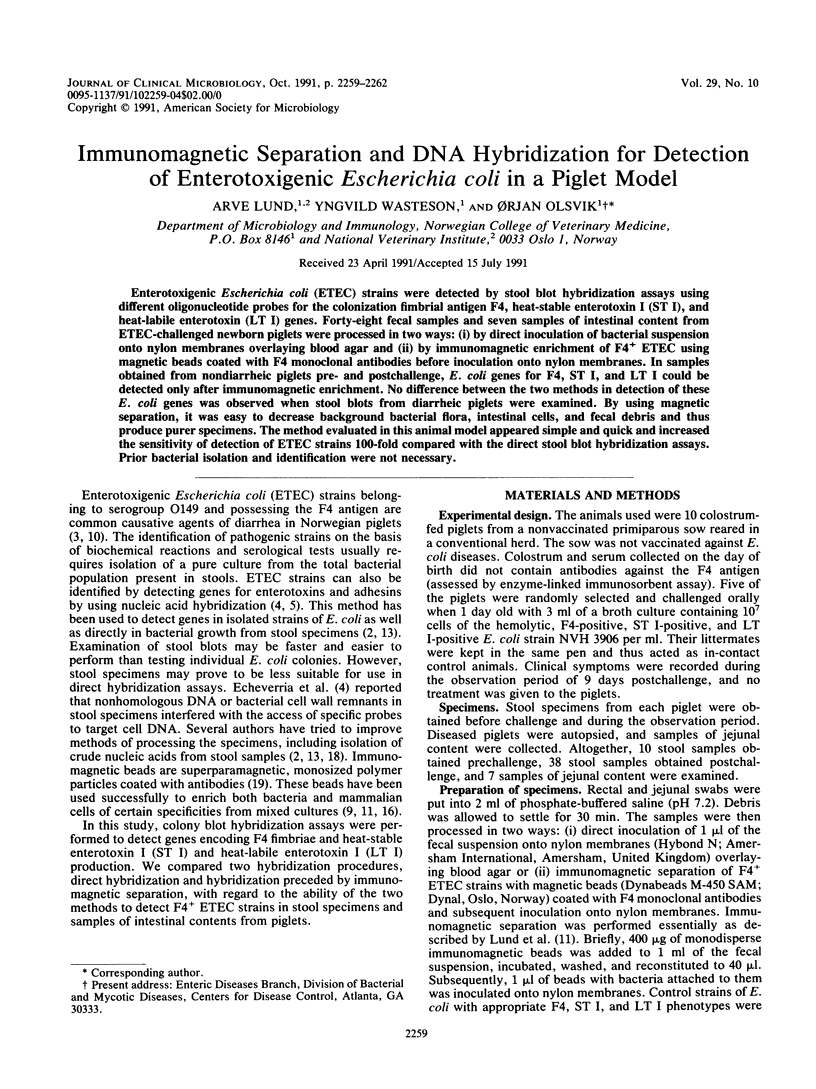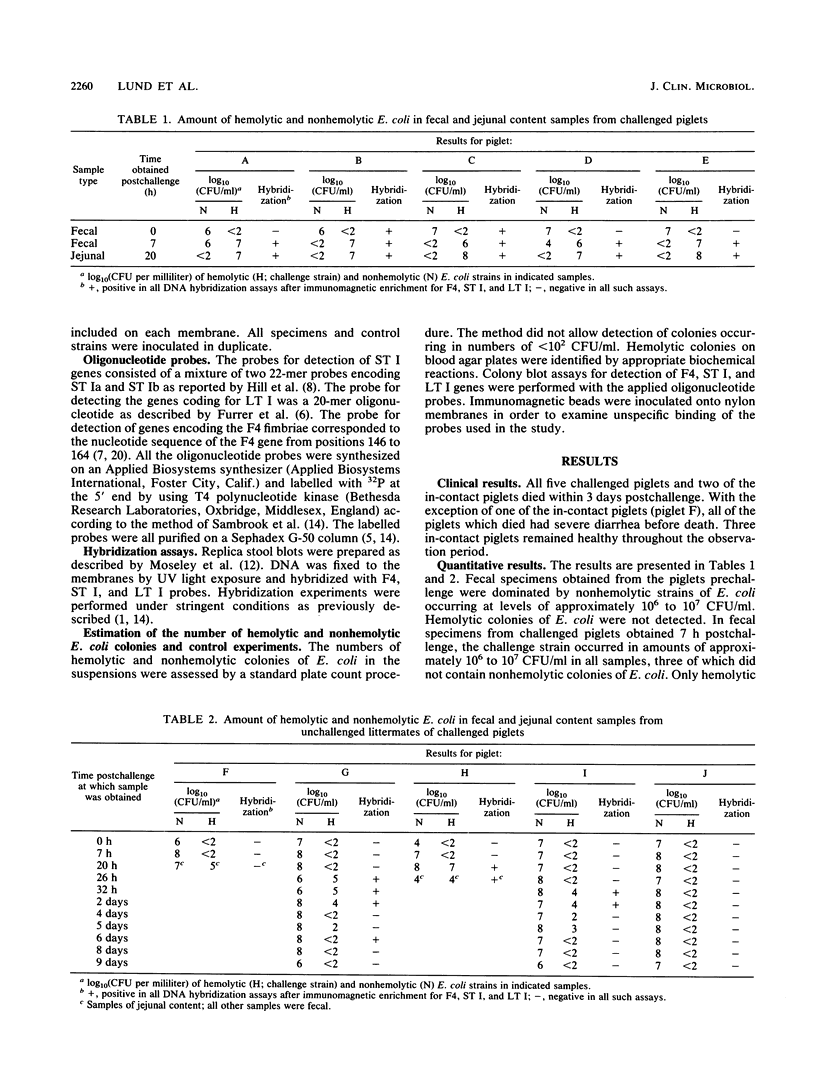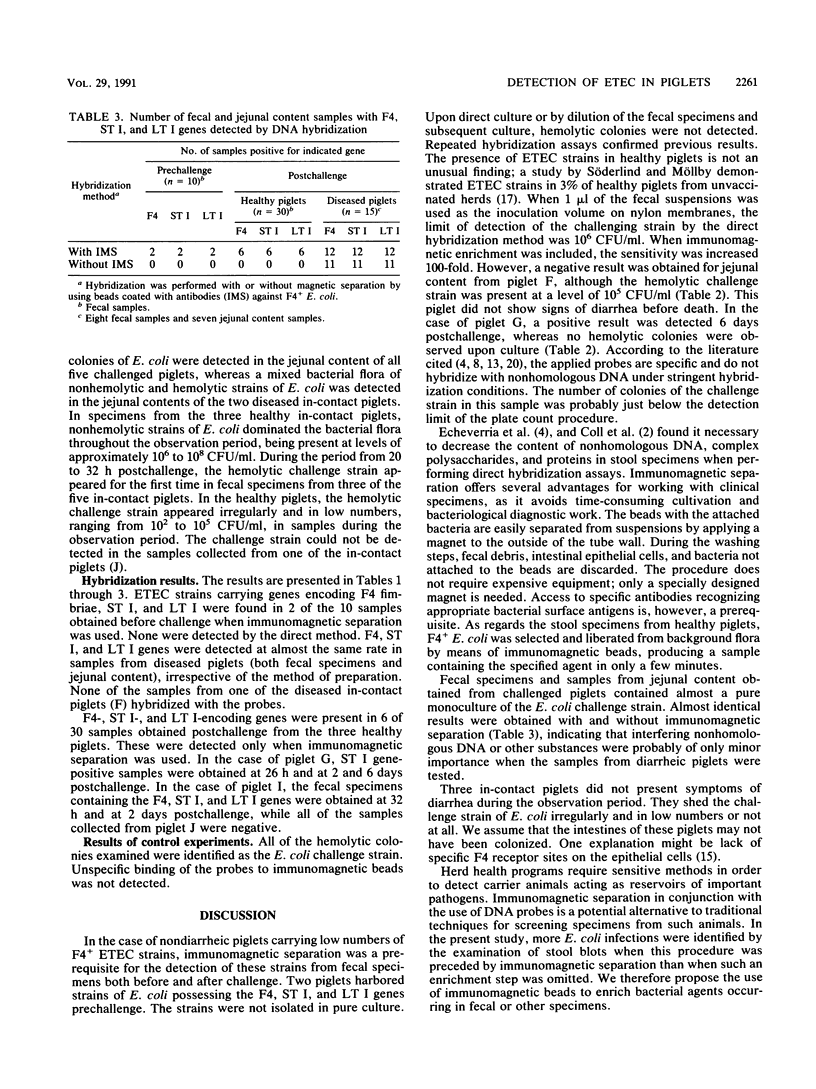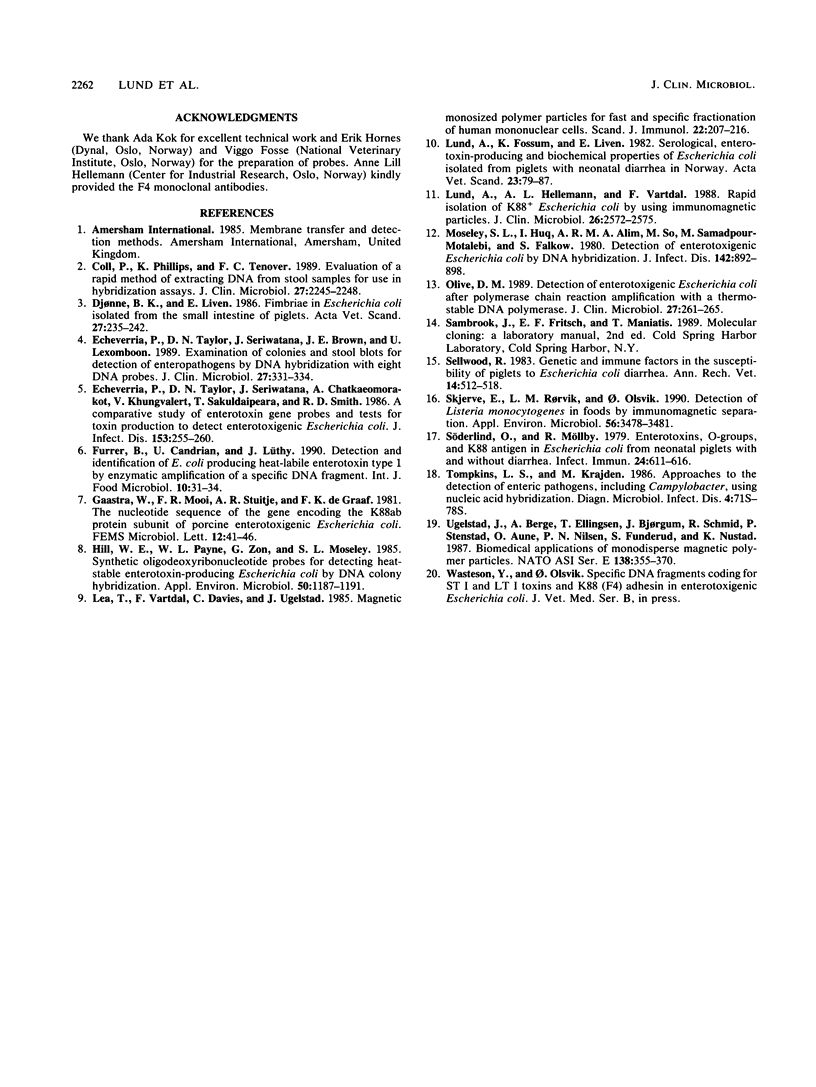Abstract
Enterotoxigenic Escherichia coli (ETEC) strains were detected by stool blot hybridization assays using different oligonucleotide probes for the colonization fimbrial antigen F4, heat-stable enterotoxin I (ST I), and heat-labile enterotoxin (LT I) genes. Forty-eight fecal samples and seven samples of intestinal content from ETEC-challenged newborn piglets were processed in two ways: (i) by direct inoculation of bacterial suspension onto nylon membranes overlaying blood agar and (ii) by immunomagnetic enrichment of F4+ ETEC using magnetic beads coated with F4 monoclonal antibodies before inoculation onto nylon membranes. In samples obtained from nondiarrheic piglets pre- and postchallenge, E. coli genes for F4, ST I, and LT I could be detected only after immunomagnetic enrichment. No difference between the two methods in detection of these E. coli genes was observed when stool blots from diarrheic piglets were examined. By using magnetic separation, it was easy to decrease background bacterial flora, intestinal cells, and fecal debris and thus produce purer specimens. The method evaluated in this animal model appeared simple and quick and increased the sensitivity of detection of ETEC strains 100-fold compared with the direct stool blot hybridization assays. Prior bacterial isolation and identification were not necessary.
Full text
PDF



Selected References
These references are in PubMed. This may not be the complete list of references from this article.
- Coll P., Phillips K., Tenover F. C. Evaluation of a rapid method of extracting DNA from stool samples for use in hybridization assays. J Clin Microbiol. 1989 Oct;27(10):2245–2248. doi: 10.1128/jcm.27.10.2245-2248.1989. [DOI] [PMC free article] [PubMed] [Google Scholar]
- Djønne B. K., Liven E. Fimbriae in Escherichia coli isolated from the small intestine of piglets. Acta Vet Scand. 1986;27(2):235–242. doi: 10.1186/BF03548167. [DOI] [PMC free article] [PubMed] [Google Scholar]
- Echeverria P., Taylor D. N., Seriwatana J., Brown J. E., Lexomboon U. Examination of colonies and stool blots for detection of enteropathogens by DNA hybridization with eight DNA probes. J Clin Microbiol. 1989 Feb;27(2):331–334. doi: 10.1128/jcm.27.2.331-334.1989. [DOI] [PMC free article] [PubMed] [Google Scholar]
- Echeverria P., Taylor D. N., Seriwatana J., Chatkaeomorakot A., Khungvalert V., Sakuldaipeara T., Smith R. D. A comparative study of enterotoxin gene probes and tests for toxin production to detect enterotoxigenic Escherichia coli. J Infect Dis. 1986 Feb;153(2):255–260. doi: 10.1093/infdis/153.2.255. [DOI] [PubMed] [Google Scholar]
- Furrer B., Candrian U., Lüthy J. Detection and identification of E. coli producing heat-labile enterotoxin type I by enzymatic amplification of a specific DNA fragment. Lett Appl Microbiol. 1990 Jan;10(1):31–34. doi: 10.1111/j.1472-765x.1990.tb00088.x. [DOI] [PubMed] [Google Scholar]
- Hill W. E., Payne W. L., Zon G., Moseley S. L. Synthetic oligodeoxyribonucleotide probes for detecting heat-stable enterotoxin-producing Escherichia coli by DNA colony hybridization. Appl Environ Microbiol. 1985 Nov;50(5):1187–1191. doi: 10.1128/aem.50.5.1187-1191.1985. [DOI] [PMC free article] [PubMed] [Google Scholar]
- Lea T., Vartdal F., Davies C., Ugelstad J. Magnetic monosized polymer particles for fast and specific fractionation of human mononuclear cells. Scand J Immunol. 1985 Aug;22(2):207–216. doi: 10.1111/j.1365-3083.1985.tb01873.x. [DOI] [PubMed] [Google Scholar]
- Lund A., Fossum K., Liven E. Serological, enterotoxin-producing and biochemical properties of Escherichia coli isolated from piglets with neonatal diarrhea in Norway. Acta Vet Scand. 1982;23(1):79–87. doi: 10.1186/BF03546824. [DOI] [PMC free article] [PubMed] [Google Scholar]
- Lund A., Hellemann A. L., Vartdal F. Rapid isolation of K88+ Escherichia coli by using immunomagnetic particles. J Clin Microbiol. 1988 Dec;26(12):2572–2575. doi: 10.1128/jcm.26.12.2572-2575.1988. [DOI] [PMC free article] [PubMed] [Google Scholar]
- Moseley S. L., Huq I., Alim A. R., So M., Samadpour-Motalebi M., Falkow S. Detection of enterotoxigenic Escherichia coli by DNA colony hybridization. J Infect Dis. 1980 Dec;142(6):892–898. doi: 10.1093/infdis/142.6.892. [DOI] [PubMed] [Google Scholar]
- Olive D. M. Detection of enterotoxigenic Escherichia coli after polymerase chain reaction amplification with a thermostable DNA polymerase. J Clin Microbiol. 1989 Feb;27(2):261–265. doi: 10.1128/jcm.27.2.261-265.1989. [DOI] [PMC free article] [PubMed] [Google Scholar]
- Sellwood R. Genetic and immune factors in the susceptibility of piglets to Escherichia coli diarrhoea. Ann Rech Vet. 1983;14(4):512–518. [PubMed] [Google Scholar]
- Skjerve E., Rørvik L. M., Olsvik O. Detection of Listeria monocytogenes in foods by immunomagnetic separation. Appl Environ Microbiol. 1990 Nov;56(11):3478–3481. doi: 10.1128/aem.56.11.3478-3481.1990. [DOI] [PMC free article] [PubMed] [Google Scholar]
- Söderlind O., Möllby R. Enterotoxins, O-groups, and K88 antigen in Escherichia coli from neonatal piglets with and without diarrhea. Infect Immun. 1979 Jun;24(3):611–616. doi: 10.1128/iai.24.3.611-616.1979. [DOI] [PMC free article] [PubMed] [Google Scholar]
- Tompkins L. S., Krajden M. Approaches to the detection of enteric pathogens, including Campylobacter, using nucleic acid hybridization. Diagn Microbiol Infect Dis. 1986 Mar;4(3 Suppl):71S–78S. doi: 10.1016/s0732-8893(86)80044-x. [DOI] [PubMed] [Google Scholar]


